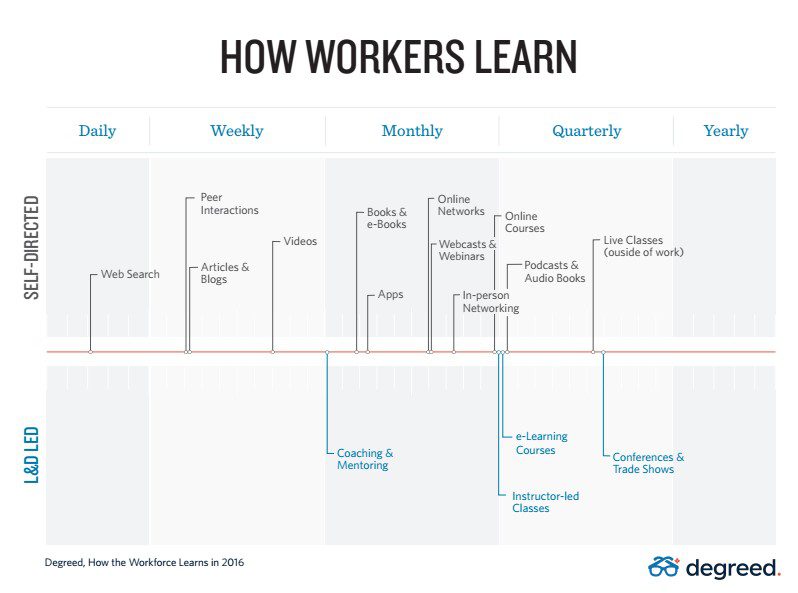
Most CLOs are working hard to connect with their workforce. According to the Brandon Hall Group, 61 percent of learning and development leaders think workers should engage with their resources at least once-a-week. Yet, in a webinar poll conducted with Chief Learning Officer earlier this year, only 20 percent of learning leaders said their employees do that.
To help learning and development teams better engage employees, Degreed recently surveyed 512 people to understand how today’s workforce builds their skills and careers. The findings, summarized in the “How the Workforce Learns in 2016” report, call out three common myths about workplace learning.
Myth 1: Workers don’t have time for learning. Truth: People will make time to learn if it fuels their careers or enriches their lives. Bersin by Deloitte reported that 88 percent of learning professionals believe employees don’t have or make the time to engage with corporate learning. And lack of time is the most commonly cited obstacle to learning in the workplace. But our data suggests that’s not quite the whole story.
Our survey respondents spend, on average, just 37 minutes per week on employer-provided training, but they also put in 3.3 hours per week learning on their own. Nearly two-thirds said they would find more time if they received some kind of credit or recognition they could leverage for professional growth. They want more than the typical LMS catalog, though. Nearly 75 percent said they invested their own money in career development over the past year.
That indicates most people will readily invest in their own learning and development — if they believe it will help them be better at their jobs, advance their careers or enrich their lives. So, don’t just train workers to follow processes and comply with policies. To really engage workers, help them grow, evolve and stay marketable.
Myth 2: Traditional training methods, like classroom training and online courses, are obsolete. Truth: Traditional methods are not obsolete. They’re just incomplete. It’s become fashionable to say that learning is wildly out of sync with how people learn and that the only real remedy is a revolution. Self-service microlearning, many say, is the future. It’s not that simple.
Bite-sized content dominates learning habits now. In any given week, 85 percent of people we surveyed said they learn something for work through online search. Nearly 70 percent said they develop themselves by reading articles or blogs, and more than half use videos.
Formal training, however, is still an essential part of how workers develop new skills and keep their old ones fresh. Around 70 percent of people we surveyed indicate they take live, virtual or e-learning courses from their employers at least once a year. And many do so every few months.
 A lot of that learning is happening on their own, or via peers and managers. But L&D today is not the either/or proposition some make it out to be. To build a culture of learning, learning leaders need it all now: business-led training and self-service learning, formal and informal, job training and career development, courses and resources. That’s how today’s workers really learn.
A lot of that learning is happening on their own, or via peers and managers. But L&D today is not the either/or proposition some make it out to be. To build a culture of learning, learning leaders need it all now: business-led training and self-service learning, formal and informal, job training and career development, courses and resources. That’s how today’s workers really learn.
Myth 3: The learning function owns responsibility for employee development. Truth: Responsibility for learning is shared between the learning function, managers and employees. According to CEB, learning leaders believe that four in five workers are “bad at learning” — that they don’t know when to ask for help or share what they know, how to seek out relevant knowledge, or how to extract value from information. We are not so sure. Our research suggests that most employees start their learning journeys with social or search, not in the learning department.
Just 21 percent of people told us they rely directly on their learning department when they need to learn something new for work, and only 28 percent said they search their employers’ learning management system first. Instead, they look to their boss or mentor (69 percent), their colleagues (55 percent) or search online (47 percent) much more frequently.
That doesn’t mean people don’t need learning and development. Those who said they have adequate guidance are significantly more satisfied with their employer’s learning opportunities than those who don’t have any direction. Instead, learning teams have two roles now: The traditional role: creating, buying and delivering training; and a new, indirect role: giving meaning to self-serve learning by building and curating an environment and a culture that empowers workers to discover and connect with the right people, experiences and resources on their own.
Learning follows the path of least resistance, so now, speed, simplicity and easy access matter most. Smarter CLOs are already rebalancing their investments to empower more and manage less. According to Bersin by Deloitte’s 2015 “Corporate Learning Factbook,” more “mature” learning teams deliver 20 percent fewer hours of formal training, up to 30 percent more learning on-the-job, 13 percent more via coaching and collaboration, and nearly 100 percent more through on-demand resources like videos, articles and books.
Balancing organizational imperatives with individual ones is now a requirement for CLOs. Employees need training for now and development for later, formal training sometimes and informal learning all the time, as well as control and autonomy. “Either/or” won’t work for today’s workers. Most L&D leaders seem to understand that already.
More than 60 percent the people we polled in our Chief Learning Officer webinar said they are already rethinking their learning strategies to adapt to the expectations and demands of today’s workers. Almost half said they are investing in more modern content (40 percent) or new technology (48 percent).
But fewer are modernizing their own approaches. Only 42 percent told us they are reorganizing, just 31 percent are re-skilling their staff and merely 21 percent are recruiting for new learning and development skills. Before learning leaders do anything, they should get to know their workforce a lot better. Evaluate whether they have not just the right strategy and tools, but also the capabilities needed to build the learning culture they want.
Todd Tauber is vice president of product marketing for Degreed. To comment, email editor@CLOmedia.com.














